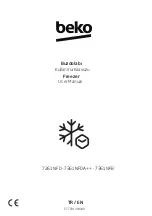
10
Operation and Controls
Prior to storing the frozen food, pack it in plastic bags, aluminum sheets or freezing containers and place into
the glass door freezer.
Fresh foods should not be stored together with frozen foods.
Do not keep glass-bottled drinks such as beer or soda, as the glass may shatter and canned items may burst.
Do not use this glass door freezer as a refrigerator as food can become frozen.
NOTE: For best performance, leave enough space inside the
glass door
freezer cabinet for air to circulate around
the packages.
DEFROSTING AND DRAINING
WARNING: Before proceeding with cleaning and maintenance operations, make sure the power cord of the unit is
disconnected. Do not touch the power cord when your hands are wet. Never unplug the unit by pulling on the plug.
To avoid damaging the inside cabinet wall, never use a sharp or metallic instrument to scrape off frost or separate
the frozen contents.
Moisture contained in food and air may form a layer of frost inside the unit after a period of use. We highly recom-
mend that the unit gets defrosted when frost becomes ¼” thick. The defrosting process for this unit is operated
manually.
For complete defrosting:
1. Unplug the unit from its power source.
2. Remove all contents and place it in corrugated boxes, insulated bags, picnic cooler, etc. Use towels and news-
paper for insulation as needed.
3. With the door open, use pans of hot water to speed the loosening of the frost. Remove large pieces of before
they melt.
4. Remove the clear drain plug from the inside base cabinet of the freezer. Water drained from the base of the
freezer will be expelled out to the drain tube located at the back side of the freezer. Ensure that a container is
placed under the drain tube before removing the drain plug located within inside the base cabinet.
5. Sponge excess water from the bottom of the freezer.
6. After defrosting, clean the inside and dry with a soft cloth to wipe away the remaining ice and water.
Once the compartment is wiped and dry, replace the drain plug and plug in the freezer. Return the temperature
value to its previous setting and return food to the freezer.
NOTE:
Do not use mechanical devices or other means to accelerate the defrosting process. DO NOT pour
hot water directly into the cabinet or heat with hair dryer while defrosting.
NORMAL SOUNDS
Your glass door freezer may make sounds that are not familiar to you. Hard surfaces like the some flooring and
walls can make the sounds seem louder than they actually are. The following describes the kinds of sounds that
may be new to you a description of the cause of the sound.
Ratting noises may come from the flow of the refrigerant or the water line, items stored on top of the up-right
freezer can also make noises.
The high efficiency compressor may make a pulsating or high-pitched sound.
Noise emitted by the cooling fan on the condenser is a normal function.
It is normal for the fan in the power supply to run all the time.
As each cycle ends, you may hear a gurgling sound due to the refrigerant flowing in your glass door freezer.
The surface temperature of the compressor can reach 158 - 194°F when running.

































